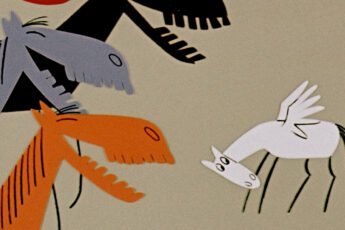
The job of editing film essays and even reviews can be unrewarding. An editor may spend hours guessing the intentions behind a text, polishing vocabulary and twisting sentences so that they still sound like those of the author. A good editor is like a referee in a good tennis match – they stay unnoticed. Change too much and you will offend the author. Change too little and you may offend the reader. Editing builds a connection between these two imagined audiences. A seemingly innocuous-sounding sentence may hide whole libraries of cultural references, historical contexts, and personal experiences.
Take the use of “very” before a noun, as in the Hegel dictum “Evil resides in the very gaze which perceives Evil all around itself”. This use of “very” is different from its more common role as an adverb modifying adjectives or other adverbs, as in “Hegel is very difficult to read”. In Hegel’s phrase, “very” intensifies “gaze” and serves to denote that it is precisely, or specifically, in the gaze wherein evil resides. In this case, it emphasizes the essence of what is being discussed. It draws attention to the active role of the observer in the dynamics of moral judgment – it is not the existence of evil in and of itself but how it is viewed that shapes its reality. More often than not, this use of “very” is unnecessary. For example, in the sentence, “at the very beginning of the film”, the reader does not, in most cases, need to be informed of the specific significance of “beginning”.
Google BNgram Viewer, a tool that scrolls through a large corpora of scanned books, maps the use of “very” as a determiner in the English language as a relic of the 19th century. In the 1850s it steadily declined until the early 1990s. Since then, it has been on a constant rise. Writing in the early 1800s, Hegel used it over sixty times in his Phenomenology of Spirit and over eighty times in his Logic. By contrast, in Derek Parfit’s Reasons and Persons of 1984, which was written during the 1970s and 1980s, we can only find five uses of “very” in this way. One way to understand the post-1990 revival of “very” as a determiner, is to put oneself in the minds of writers using it. The 1990s marked the intensive scholarly treatment of postmodern texts in humanities departments, particularly within US-American universities. Postmodernism often favored ambiguity over clarity, subjectivity over objectivity. It challenged grand narratives and ideologies and embraced a fragmented, pluralistic approach to understanding and representing reality.
Perhaps the use of “very” as a determiner added a layer of specificity in the postmodern context that aimed to counter this inherent ambiguity. It anchored particular concepts that might have otherwise seemed fluid or contested within a text. For instance, in a sentence like “The very description of the field of gender is in no sense prior to, or separable from, the question of its normative operation,” the word “very” helps to affirm the significance of an otherwise fluid concept – it is this specific description and no other. This usage is in line with postmodernism’s tendency to question the limits of language. Judith Butler’s Gender Trouble, which was published in 1990 and from which this sentence is taken, features over eighty uses of “very” as a determiner.
In the postmodern context, the use of “very” as determiners for sentences that do not need them is ironic. It is almost as if writers trained on questioning every word needed to reassure themselves, at times, of their precision. However, it is understandable and somewhat endearing. Writers influenced by postmodern thought are likely reading texts that use similar expressions, and their experiences as readers inform their choices as authors. In that sense editing can open a window to the literary preferences of an author and sometimes even the linguistic trends of an entire era.
Language changes as words and expressions fall in and out of vogue. Today ChatGPT is shaping our language. Some of the words ChatGPT overuses are “nuanced”, “delve”, “complex”, “intricate”, and “navigate”. Its style is generally heavy on adjectives, which makes things sound “complex”, but which often remain under-complex, since ChatGPT is unable to provide reasons to make sense of the adjectives it uses. In a sentence like “she found herself navigating the intricate responsibilities of motherhood alone”, taken from a UNICEF report on malnutrition, the reader is provided a characterization of the relevant responsibilities as being intricate instead of an explanation of what such responsibilities are, or of what they entail for a human being. Stripped off its flamboyant yet uninformative style, the sentence just says, “she was a single mother”.
Just like for any epoch, this style may be speaking to us in a way that we find particularly appealing. It offers a semblance of depth and understanding, providing the illusion of comprehension and expertise, while in reality, it only skims the surface of topics. To say it in good-old postmodern style: it circumvents the very complexity it is trying to address. It is not surprising that this language is flourishing in institutions that have difficulties facing the complexities of the problems they were meant to solve.
There is an obvious lack of accountability in outsourcing thought-processes to machines. Linguistically, nothing makes this more palpable than the use of embellished language to simulate depth where there is none. However, it would be mistaken to blame the machine, just as it is mistaken to blame postmodernism, or Hegel, for the prevalent use or misuse of certain expressions. If editing is a window into the linguistic zeitgeist, revealing how language is shaped and reshaped to meet contemporary needs, observing the increasing usage of this kind of surface language reflects contemporary tendencies towards digestible modes of communication that prioritize the appearance of knowledge over its actual acquisition and application.
***
Three films featured in this month’s issues – all written by women critics – relate stories of women defying societal rules and oppression. Lena Streitwieser offers an analysis of the role of remembering and its connection to womanhood in Márta Mészáros’ Diary for My Children. Margarita Kirilkina reviewed Katalin Moldovai’s Without Air about a school principal’s struggle against bureaucracy as well as Malika Musaeva’s The Cage Is Looking for a Bird about young women in a remote Caucasian village with dreams of escaping their hometown.
Our January issue also features Julia Skala’s discussion of four animated shorts from the Pannónia Filmstúdió showcasing Hungarian artists’ quest for artistic freedom. At this year’s Crossing Europe film festival, Jack Page saw Bottlemen, Nemanja Vojinović’s documentary set around the world’s second-most polluted landfill. Finally, we are publishing Martin Kudláč’s review of Maciek Hamela’s In the Rearview, which offers a civilian-focused documentary about the Russo-Ukrainian war.
We hope you enjoy our reads.
Konstanty Kuzma & Moritz Pfeifer
Editors




Leave a Comment